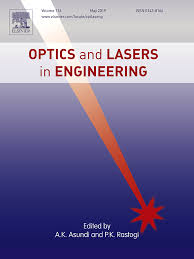Speckle phenomenon helps to monitor plants stress

The Laser Speckle Laboratory in the Joint Laboratory of Optics has developed a non-invasive method for monitoring plants' responses to induced stress. Speckle is a phenomenon in which the matt (optically rough) surface of an object is illuminated by a coherent laser beam and the reflected light field shows a typical speckled pattern caused by interference of light reflected off different points of the object. The pattern of the reflected light field (speckle field) is sensitive to the object movements and deformations and thus allows the changes that the surface of the object undergoes to be precisely tracked. The speckle effect also arises when the laser beam passes through a translucent object.
In the case of an experiment recently carried out in cooperation with several Olomouc workplaces, the tested objects were tomato leaflets after their detachment from the maternal plant. The speckle field after the light beam passed through the leaflet, or the field planar section known as the speckle pattern, was recorded by a CMOS matrix camera for almost two days. Mathematical statistics, applied to the recorded images of speckle patterns, is used to describe the dynamic changes taking place within the leaflet under test. The proposed statistical indicators allow the time behaviour of the dynamic response to be analysed both over the whole selected leaflet area and at different points in this area.
Dynamic processes reflecting stress responses in the vascular bundle and mesophyll cells of the leaflet are investigated. Although processes in the vascular bundle gradually cease, processes in the mesophyll cells show the opposite response to the stress caused by the leaflet detachment. Significant dynamic response heterogeneity is thus detected within a single leaflet designating this optical technique for opening up a new avenue for non-invasive monitoring of biological samples.
The experiments were conducted for several years in collaboration of the Joint Laboratory of Optics (P. Horváth, P. Šmíd) with the Department of Biophysics (J. Pechník) and the Department of Chemical Biology (V. Nožková). The Department of Biophysics provided plant samples for the experiments. These plants were cultivated in a growth chamber under controlled conditions. Next, the Department of Chemical Biology provided expert consultations focused on the problem of plant behaviour under stress. The achieved results of the experiments were published in the prestigious journal Optics and Lasers in Engineering [Horváth2024] and also presented at an international conference ODAM 2023 [Šmíd 2023a, Šmíd 2023b].

[Horváth2024] Horváth, P., Šmíd, P., Nožková, V., Pechník, J. Non-invasive optical technique based on speckle phenomenon for application in plant stress physiology. Optics and Lasers in Engineering 172, 107870, 2024.DOI: 10.1016/j.optlaseng.2023.107870.
[Šmíd2023a] Šmíd, P., Horváth P., Nožková V., Pechník J.: Statistical Characteristics in Study of Structural Changes During Desiccation Stress of Plant Leaf by Speckle Effect. In: Fišerová, E.; Hron, K.; Machalová, (eds.) Book of abstracts Olomoucian Days of Applied Mathematics 2023 (ODAM), 12-14. 6. 2023, Olomouc, p. 71, 2023.
[Šmíd2023b] Šmíd, P., Horváth P., Nožková V., Pechník J.: Statistical Characteristics in Study of Structural Changes During Desiccation Stress of Plant Leaf by Speckle Effect, Olomoucian Days of Applied Mathematics 2023 (ODAM), 12-14. 6. 2023, Olomouc. Poster.



